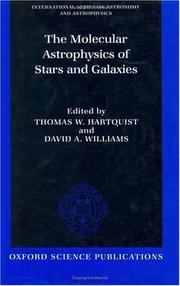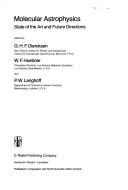| Listing 1 - 10 of 24 | << page >> |
Sort by
|
Book
ISBN: 1107439299 1107424046 1139087444 Year: 2013 Publisher: Cambridge : Cambridge University Press,
Abstract | Keywords | Export | Availability | Bookmark
 Loading...
Loading...Choose an application
- Reference Manager
- EndNote
- RefWorks (Direct export to RefWorks)
Molecular line emissions offer researchers exciting opportunities to learn about the evolutionary state of the Milky Way and distant galaxies. This text provides a detailed introduction to molecular astrophysics and an array of useful techniques for observing astronomical phenomena at millimetre and submillimetre wavelengths. After discussing the theoretical underpinnings of molecular observation, the authors catalogue suitable molecular tracers for many types of astronomical regions in local and distant parts of the Universe, including cold gas reservoirs primed for the formation of new stars, regions of active star formation, giant photon-dominated regions and near active galactic nuclei. Further chapters demonstrate how to obtain useful astronomical information from raw telescope data while providing recommendations for appropriate observing strategies. Replete with maps, charts and references for further reading, this handbook will suit research astronomers and graduate students interested in broadening their skill to take advantage of the new facilities now coming online.
Book
ISBN: 9781107018167 9781139087445 Year: 2013 Publisher: New York, NY : Cambridge University Press,
Abstract | Keywords | Export | Availability | Bookmark
 Loading...
Loading...Choose an application
- Reference Manager
- EndNote
- RefWorks (Direct export to RefWorks)
"Molecular line emissions offer researchers exciting opportunities to learn about the evolutionary state of the Milky Way and distant galaxies. This text provides a detailed introduction to molecular astrophysics and an array of useful techniques for observing astronomical phenomena at millimetre and submillimetre wavelengths. After discussing the theoretical underpinnings of molecular observation, the authors catalogue suitable molecular tracers for many types of astronomical regions in local and distant parts of the Universe, including cold gas reservoirs primed for the formation of new stars, regions of active star formation, giant photon-dominated regions and near active galactic nuclei. Further chapters demonstrate how to obtain useful astronomical information from raw telescope data while providing recommendations for appropriate observing strategies. Replete with maps, charts and references for further reading, this handbook will suit research astronomers and graduate students interested in broadening their skill to take advantage of the new facilities now coming online" -- Provided by publisher.
Book
ISBN: 1316766810 1316761770 1316718492 Year: 2021 Publisher: Cambridge : Cambridge University Press,
Abstract | Keywords | Export | Availability | Bookmark
 Loading...
Loading...Choose an application
- Reference Manager
- EndNote
- RefWorks (Direct export to RefWorks)
Focusing on the organic inventory of regions of star and planet formation in the interstellar medium of galaxies, this comprehensive overview of the molecular universe is an invaluable reference source for advanced undergraduates through to entry-level researchers. It includes an extensive discussion of microscopic physical and chemical processes in the universe; these play a role in the excitation, spectral characteristics, formation, and evolution of molecules in the gas phase and on grain surfaces. In addition, the latest developments in this area of molecular astrophysics provide a firm foundation for an in-depth understanding of the molecular phases of the interstellar medium. The physical and chemical properties of gaseous molecules, mixed molecular ices, and large polycyclic aromatic hydrocarbon molecules and fullerenes and their role in the interstellar medium are highlighted. For those with an interest in the molecular universe, this advanced textbook bridges the gap between molecular physics, astronomy, and physical chemistry.
Periodical
ISSN: 24056758
Abstract | Keywords | Export | Availability | Bookmark
 Loading...
Loading...Choose an application
- Reference Manager
- EndNote
- RefWorks (Direct export to RefWorks)
Molecular astrophysics --- Molecular astrophysics. --- Astrophysics
Periodical
ISSN: 2405674X Year: 2015 Publisher: Amsterdam Elsevier,
Abstract | Keywords | Export | Availability | Bookmark
 Loading...
Loading...Choose an application
- Reference Manager
- EndNote
- RefWorks (Direct export to RefWorks)
Molecular astrophysics --- Molecular astrophysics. --- Astrophysics

ISBN: 0198501587 Year: 1998 Publisher: Oxford : Clarendon press,
Abstract | Keywords | Export | Availability | Bookmark
 Loading...
Loading...Choose an application
- Reference Manager
- EndNote
- RefWorks (Direct export to RefWorks)
This book provides a comprehensive survey of modern molecular astrophysics. It gives an introduction to molecular spectroscopy and then addresses the main areas of current molecular astrophysics, including galaxy formation, star forming regions, mass loss from young as well as highly evolved stars and supernovae, starburst galaxies plus the tori and discs near the central engines of active galactic nuclei. With chapters written by leading experts, the book is unique in giving a detailed view of this wide-ranging subject. It will provide the standard introduction for research students in molecular astrophysics; it will also enable chemists to learn the astrophysics most related to chemistry as well as instruct physicists about the molecular processes most important in astronomy.
Galaxies. --- Molecular astrophysics. --- Stars.
Book
Year: 1998 Publisher: Boston Kluwer Academic Publishers
Abstract | Keywords | Export | Availability | Bookmark
 Loading...
Loading...Choose an application
- Reference Manager
- EndNote
- RefWorks (Direct export to RefWorks)
Book
ISBN: 0511564686 Year: 1990 Publisher: Cambridge : Cambridge University Press,
Abstract | Keywords | Export | Availability | Bookmark
 Loading...
Loading...Choose an application
- Reference Manager
- EndNote
- RefWorks (Direct export to RefWorks)
This self-contained introduction to molecular astrophysics is suitable as a text for advanced postgraduate courses on interstellar matter. It is an excellent summary of present knowledge and outstanding questions and will be valued by research astrophysicists, physical chemists, atomic and molecular physicists and atmospheric scientists who wish to become familiar with this field. Descriptions are given of the distributions and types of molecules observed in galactic and extragalactic sources, including those in the vicinity of active galactic nuclei. The chemistry of diffuse and dense clouds is also discussed, and chemical reactions in shocks and dynamically evolving clouds are considered.

ISBN: 9027720819 9401088985 9400954328 Year: 1985 Volume: vol 157 Publisher: Dordrecht : Reidel,
Abstract | Keywords | Export | Availability | Bookmark
 Loading...
Loading...Choose an application
- Reference Manager
- EndNote
- RefWorks (Direct export to RefWorks)
Astronomical spectroscopy --- Interstellar molecules --- Molecular astrophysics --- Congresses.
Book
ISBN: 1282760041 9786612760044 184816470X 9781848164703 1848164696 9781848164697 Year: 2010 Publisher: London Imperial College Press
Abstract | Keywords | Export | Availability | Bookmark
 Loading...
Loading...Choose an application
- Reference Manager
- EndNote
- RefWorks (Direct export to RefWorks)
This unique volume is a compendium of scientific contributions inspired by the work of Alex Dalgarno in the fields of atomic, molecular, and optical physics, astrophysics, astrochemistry, and atmospheric physics. The book should be of particular value to the practitioners in these fields.
Astrophysics --- Molecular astrophysics --- Atmospheric physics --- Cosmochemistry
| Listing 1 - 10 of 24 | << page >> |
Sort by
|

 Search
Search Feedback
Feedback About UniCat
About UniCat  Help
Help News
News